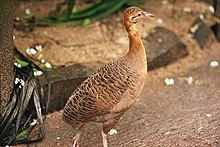| Nothurinae Temporal range: Mid-
Miocene to present
| |
|---|---|

| |
| Rhynchotus rufescens | |
|
Scientific classification
| |
| Domain: | Eukaryota |
| Kingdom: | Animalia |
| Phylum: | Chordata |
| Class: | Aves |
| Infraclass: | Palaeognathae |
| Order: | Tinamiformes |
| Family: | Tinamidae |
| Subfamily: | Nothurinae |
| Genera | |
| Synonyms [1] | |
| |
Nothurinae or aridland tinamous [2] is one of two subfamilies of the Tinamidae family, the other being Tinaminae. It contains eighteen species in six genera. The six genera are:
- Rhynchotus (2 species)
- Nothoprocta (6 species)
- Nothura (5 species)
- Taoniscus ( monotypic) - dwarf tinamou
- Eudromia (2 species)
- Tinamotis (2 species)
Description
These birds, as a member of the tinamou, are ground birds that prefer to run and walk, but will fly when needed. [3]
Taxonomy
They are related to the ratites ( emus, ostriches, kiwis, and rheas), and are placed with them in the Paleognathae. All of these birds evolved from ancient birds that did fly and tinamous are believed to be a still living primitive family closely related to these ancient birds. [3]
Behavior
Tinamous eat leaves, buds, small fruits and seeds, and will eats insects for variety. [3]
Range and habitat
The members of this subfamily live in South America and prefer hills and arid grasslands and scrublands as opposed to the Tinaminae, which prefer forests. [2]
Footnotes
References
- Brown, Joseph W. (2005). "Tinamiformes, Tinamidae, tinamous". Tree of Life Web Project. Retrieved 16 Jul 2009.
- Davies, S. J. J. F. (2003). "Tinamous (Tinamidae)". In Hutchins, Michael; Jackson, Jerome A.; Bock, Walter J.; Olendorf, Donna (eds.). Grzimek's Animal Life Encyclopedia. Vol. 8 Birds I Tinamous and Ratites to Hoatzins. Joseph E. Trumpey, Chief Scientific Illustrator (2nd ed.). Farmington Hills, MI: Gale Group. pp. 57–67. ISBN 0-7876-5784-0.


